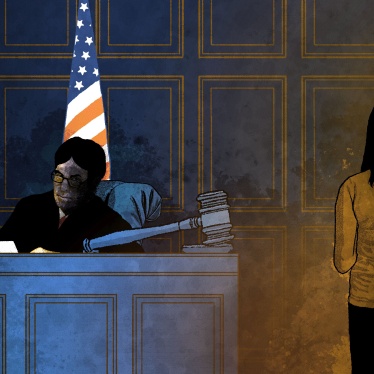Human Rights Watch appreciates the opportunity to provide a submission to the United Nations Office of the High Commissioner for Human Rights on climate change and child rights, in advance of its work on a panel discussion and analytical study on the topic. Human Rights Watch welcomes the Human Rights Council’s attention to the effects of climate change on the environment and its disproportionate impact on children, and the exclusion of children from governmental processes to prevent, mitigate, and remedy these impacts.
Millions of children around the world suffer violations of their rights because of problematic government responses to environmental degradation and climate change. Children from marginalized groups—such as from indigenous communities and communities facing caste-based discrimination—are often disproportionately affected. Girls are particularly at risk. Human Rights Watch has documented some of these issues through fact-finding investigations in Bangladesh, Kenya, and Malawi.
National environmental and climate change laws and policies rarely address the rights of children. International environmental agreements have long ignored a human rights approach, including the rights of children. The Paris Agreement adopted by states parties of the United Nations Framework Convention on Climate Change (UNFCCC), however, recognizes the need to respect human rights, including child rights, in its preamble and takes a more integrated approach to human rights and environmental issues.
Key players such as the United Nations Children’s Fund (UNICEF), child rights organizations, and the UN special rapporteur on human rights and the environment have recently highlighted the extremely harmful impacts of climate change on the environment and the ability of governments to protect the rights of children. International human rights bodies have also increasingly emphasized the impact of climate change on the environment and the harms to children. For example, the Committee on the Rights of the Child has stated that environmental interventions should "address climate change, as this is one of the biggest threats to children’s health and exacerbates health disparities” and recommended that states put children’s health concerns at the center of their climate change adaptation and mitigation strategies.[1] In 2016, the Committee in its Concluding Observations to the United Kingdom expressed concern about the “high level of air pollution that directly affects child health“ and “contributes to the negative impact of climate change affecting various rights of the child,” both domestically and in other countries.[2]
Most recently, at the Day of General Discussion on Child Rights and the Environment in September 2016, Committee members affirmed that "Children’s rights were overlooked in national and international climate policies, and climate change was frequently omitted from child-related policies.”[3] This is, therefore, an important moment to take action to protect children from harms related to climate change.
Human Rights Watch research on child rights and climate change
Access to health, food, and water
The effects of climate change already endanger many children’s access to water, food, and health care. There is an urgent need for governments to address the consequences of climate change on children and uphold their human rights. Children from indigenous communities are often particularly vulnerable because their culture and livelihood is often tied to their land, and such marginalized populations often lack the resources and government support to counter climate change’s effects. Girls often face particular risks, due to gender discrimination and gendered roles that make them responsible for tasks including gathering water and firewood, and washing clothing, among others.
In the Turkana region of Kenya, Human Rights Watch found that climate change, along with other environmental, political, and economic development challenges, has limited local indigenous communities’ access to food and clean water. As a result, many children have become sick because their families are unable to provide them with sufficient food and clean water. Girls often walk extremely long distances to dig for water in dry riverbeds, exposing them to dangers along the route and leaving them with less time to attend school or rest.[4] Scientific studies show that recurring drought and food insecurity can also have indirect effects on health. For example, climate change has changed the behavior of mosquitoes and ticks that transmit diseases such as malaria.[5]
Child marriage
There is growing recognition that crises in a family—including a sharp drop in income, illness, conflict, flight, and migration, but also natural disasters and the effects of climate change—can prompt child marriage. This can happen because families are struggling for survival and are more able to cope if their family size is reduced by marrying girls off, a dowry provides income, or to protect, often misguidedly, a girl in an unsafe environment who faces an elevated risk of sexual violence.
In Bangladesh, Human Rights Watch documented the stories of families who arranged child marriages for their daughters under 18 because of extreme poverty, compounded by natural disasters that were exacerbated by climate change.[6] In some areas, river erosion created a situation where families knew several years in advance that they would lose their home and land, and they married off daughters as part of their coping strategy. Given the lack of a government safety net, families often saw it as being in the best interest of both the daughter and the family as a whole for her to be married before the family lost their status as landowners, were displaced to a new area where they did not have standing in the community, and faced additional economic hardship that would likely jeopardize their most basic survival needs.
Impacts of climate-harming activities on environmental health
Climate-harming activities, such as the coal industry, which is responsible for 40 percent of global carbon emissions, threatens the health of children. Children are also at risk from exposure to hazardous substances in the context of fossil fuel extraction for which governments often do not protect them, including by failing to realize children’s right to information on environmental health issues.
In Malawi, the government’s failure to address the hazards from coal mining has threatened children’s rights to health, food, water, housing, and information.[7] In some of Malawi’s coal mining areas visited by Human Rights Watch, residents said that mining threated their livelihoods and that they and their children suffered from increasing rates of illnesses that could be mining related. Residents complained that trucks passed along narrow village roads, coating homes and local school-houses in dust, increasing prevalence of bad coughs and asthma among children. Scientific studies show that children in coal mining communities often suffer increased rates of asthma.[8] Human Rights Watch also found that girls who take on the responsibility for fetching water often have to walk longer distances to gather water from what they believe are less contaminated sources. As a result, girls lost time to attend school, earn money, and rest. Girls also often had to help their mothers caring for family members who fell ill by what could be a mining-related illness and taking care of the household and fields. [9]
Human Rights Watch recommendations
There are concrete steps that governments, the UN, and other international bodies should take to better integrate children’s rights within climate change mitigation and adaptation policies, practices and decisions.
Governments should:
- Incorporate child rights analysis and policy measures in all climate change mitigation and adaptation strategy and policy documents, including Nationally Determined Contributions and National Adaptation Communications to the UNFCCC. They should also incorporate an analysis of climate change impacts in reports submitted to human rights treaty bodies including the Committee on the Rights of the Child.
- Consult with children’s rights organizations and youth organizations while formulating such planning documents.
- Effectively monitor child rights in the context of climate change to address possible violations and conduct human rights risk assessments to identify children and their communities that are particularly vulnerable to the impacts of climate change.
- Effectively monitor children’s environmental health, including the impacts of air pollution and climate change, for example through air monitoring and other measures.
- Ensure that human rights and environmental impact assessments in the context of climate change are easily and readily available and accessible to the public including children, including by providing short summaries in non-technical language; translating the summaries and the full reports into local languages; posting them on the internet; providing copies in public buildings including local schools; and holding information sessions in directly affected communities.
The UNFCCC Secretariat should:
- Coordinate with UN Women regarding climate change impacts and their effect on girls and strategies to mitigate them.
- Work with UNICEF and the UN Population Fund to ensure that attention to climate change is incorporated into the global work that these two agencies are leading on ending child marriage.
[1] United Nations Committee on the Rights of the Child, General Comment No. 15 on the Right of the Child to the Enjoyment of the Highest Attainable Standard of Health, CRC/C/GC/15 (2013), http://tbinternet.ohchr.org/_layouts/treatybodyexternal/Download.aspx?symbolno=CRC%2FC%2FGC%2F15&Lang=en (accessed December 22, 2016), article 24.
[2] UN Committee on the Rights of the Child, Concluding Observations on the Fifth Periodic Report of the United Kingdom of Great Britain and Northern Ireland, CRC/C/GBR/CO/5, July 2016, http://tbinternet.ohchr.org/Treaties/CRC/Shared%20Documents/GBR/CRC_C_GBR_CO_5_24195_E.docx.
[3] United Nations Office of the High Commissioner for Human Rights, “Committee on the Rights of the Child holds general discussion on children’s rights and the environment,” September 23, 2016,
http://www.ohchr.org/EN/NewsEvents/Pages/DisplayNews.aspx?NewsID=20579#sthash.yIqFqQj6.dpuf (accessed December 16, 2016).
[4] Human Rights Watch, “There is No Time Left”: Climate Change, Environmental Threats, and Human Rights in Turkana County, Kenya, October 2015, https://www.hrw.org/report/2015/10/15/there-no-time-left/climate-change-environmental-threats-and-human-rights-turkana.
[5] Intergovernmental Panel on Climate Change, “Climate Change 2007: Synthesis Report. Contribution of Working Groups I, II and III to the Fourth Assessment Report of the Intergovernmental Panel on Climate Change,” 2008, https://www.ipcc.ch/publications_and_data/publications_ipcc_fourth_assessment_report_synthesis_report.htm (accessed July 13, 2016).
[6] Human Rights Watch, Marry Before Your House is Swept Away: Child Marriage in Bangladesh, June 2015, https://www.hrw.org/report/2015/06/09/marry-your-house-swept-away/child-marriage-bangladesh.
[7] Human Rights Watch, “They Destroyed Everything”: Mining and Human Rights in Malawi,” September 2016, https://www.hrw.org/report/2016/09/27/they-destroyed-everything/mining-and-human-rights-malawi.
[8] Bernard Brabin, et. al, “Respiratory Morbidity in Merseyside Schoolchildren Exposed to Coal Dust and Air Pollution,” Archives of Disease in Childhood, vol. 70 (1994), pp. 305-12; JMF Temple and AM Sykes, “Asthma and Open Cast Mining,” British Medical Journal, vol. 305(6858) (1992), pp. 396-7; Environmental Monitoring Group, “The Social and Environmental Consequences of Coal Mining in South Africa,” 2010, p. 12; “Late (Delayed) Effects of Radiation,” US Nuclear Regulatory Commission, October 25, 2010, http://pbadupws.nrc.gov/docs/ML1122/ML11229A694.pdf (accessed September, 14, 2016), p. 9.
[9] Human Rights Watch, “They Destroyed Everything.







